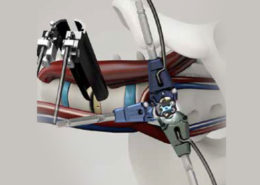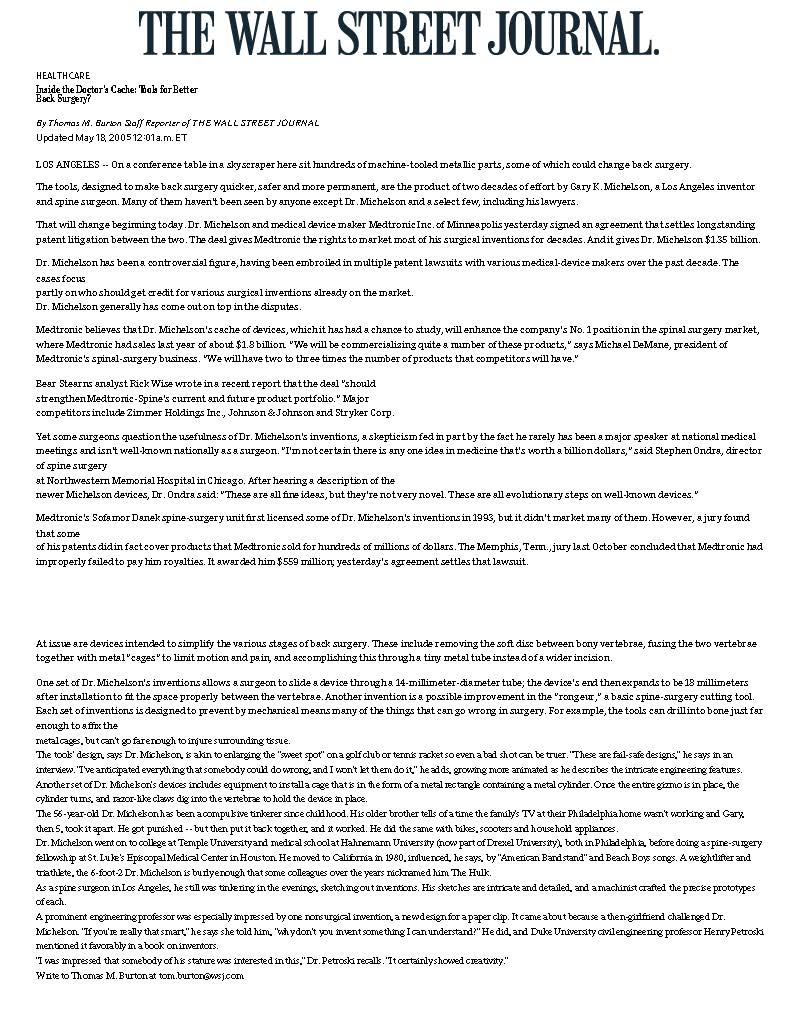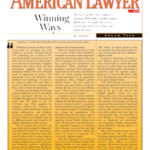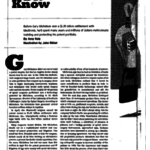Inside the Doctor's Cache: Tools for Better Back Surgery?
Thomas M. Burton Staff Reporter of the Wall Street Journal | May 18, 2005
On a conference table in a skyscraper here sit hundreds of machinetooled metallic parts, some of which could change back surgery.
The tools, designed to make back surgery quicker, safer and more permanent, are the product of two decades of effort by Gary K. Michelson, a Los Angeles inventor and spine surgeon. Many of them haven't been seen by anyone except Dr. Michelson and a select few, including his lawyers.
That will change beginning today. Dr. Michelson and medical device maker Medtronic Inc. of Minneapolis yesterday signed an agreement that settles longstanding patent litigation between the two. The deal gives Medtronic the rights to market most of his surgical inventions for decades. And it gives Dr. Michelson $1.35 billion.
Dr. Michelson has been a controversial figure, having been embroiled in multiple patent lawsuits with various medical-device makers over the past decade. The cases focus partly on who should get credit for various surgical inventions already on the market. Dr. Michelson generally has come out on top in the disputes.
Medtronic believes that Dr. Michelson's cache of devices, which it has had a chance to study, will enhance the company's No. 1 position in the spinal surgery market, where Medtronic had sales last year of about $1.8 billion. "We will be commercializing quite a number of these products," says Michael DeMane, president of Medtronic's spinalsurgery business. "We will have two to three times the number of products that competitors will have."
Bear Stearns analyst Rick Wise wrote in a recent report that the deal "should strengthen Medtronic-Spine's current and future product portfolio." Major competitors include Zimmer Holdings Inc., Johnson & Johnson and Stryker Corp.
Yet some surgeons question the usefulness of Dr. Michelson's inventions, a skepticism fed in part by the fact he rarely has been a major speaker at national medical meetings and isn't well-known nationally as a surgeon. "I'm not certain there is any one idea in medicine that's worth a billion dollars," said Stephen Ondra, director of spine surgery at Northwestern Memorial Hospital in Chicago. After hearing a description of the newer Michelson devices, Dr. Ondra said: "These are all fine ideas, but they're not very novel. These are all evolutionary steps on well-known devices."
Medtronic's Sofamor Danek spine-surgery unit first licensed some of Dr. Michelson's inventions in 1993, but it didn't market many of them. However, a jury found that some of his patents did in fact cover products that Medtronic sold for hundreds of millions of dollars. The Memphis, Tenn., jury last October concluded that Medtronic had improperly failed to pay him royalties. It awarded him $559 million; yesterday's agreement settles that lawsuit.
At issue are devices intended to simplify the various stages of back surgery. These include removing the soft disc between bony vertebrae, fusing the two vertebrae together with metal "cages" to limit motion and pain, and accomplishing this through a tiny metal tube instead of a wider incision.
One set of Dr. Michelson's inventions allows a surgeon to slide a device through a 14- millimeter-diameter tube; the device's end then expands to be 18 millimeters after installation to fit the space properly between the vertebrae. Another invention is a possible improvement in the "rongeur," a basic spine-surgery cutting tool. Each set of inventions is designed to prevent by mechanical means many of the things that can go wrong in surgery. For example, the tools can drill into bone just far enough to affix the metal cages, but can't go far enough to injure surrounding tissue.
The tools' design, says Dr. Michelson, is akin to enlarging the "sweet spot" on a golf club or tennis racket so even a bad shot can be truer. "These are fail-safe designs," he says in an interview. "I've anticipated everything that somebody could do wrong, and I won't let them do it," he adds, growing more animated as he describes the intricate engineering features. Another set of Dr. Michelson's devices includes equipment to install a cage that is in the form of a metal rectangle containing a metal cylinder. Once the entire gizmo is in place, the cylinder turns, and razor-like claws dig into the vertebrae to hold the device in place.
The 56-year-old Dr. Michelson has been a compulsive tinkerer since childhood. His older brother tells of a time the family's TV at their Philadelphia home wasn't working and Gary, then 5, took it apart. He got punished -- but then put it back together, and it worked. He did the same with bikes, scooters and household appliances.
Dr. Michelson went on to college at Temple University and medical school at Hahnemann University (now part of Drexel University), both in Philadelphia, before doing a spine-surgery fellowship at St. Luke's Episcopal Medical Center in Houston. He moved to California in 1980, influenced, he says, by "American Bandstand" and Beach Boys songs. A weightlifter and triathlete, the 6-foot-2 Dr. Michelson is burly enough that some colleagues over the years nicknamed him The Hulk. As a spine surgeon in Los Angeles, he still was tinkering in the evenings, sketching out inventions.
His sketches are intricate and detailed, and a machinist crafted the precise prototypes of each. A prominent engineering professor was especially impressed by one nonsurgical invention, a new design for a paper clip. It came about because a then-girlfriend challenged Dr. Michelson. "If you're really that smart," he says she told him, "why don't you invent something I can understand?" He did, and Duke University civil engineering professor Henry Petroski mentioned it favorably in a book on inventors. "I was impressed that somebody of his stature was interested in this," Dr. Petroski recalls. "It certainly showed creativity."



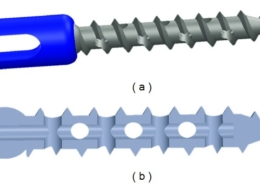
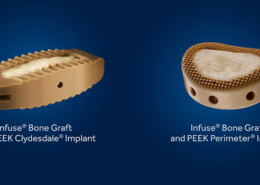 Orthopedics this Week
Orthopedics this Week